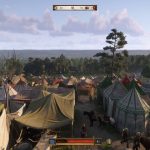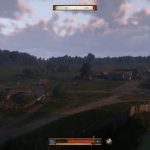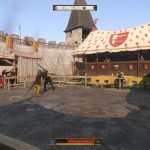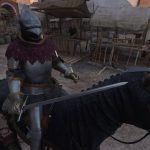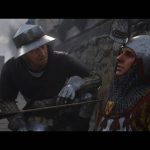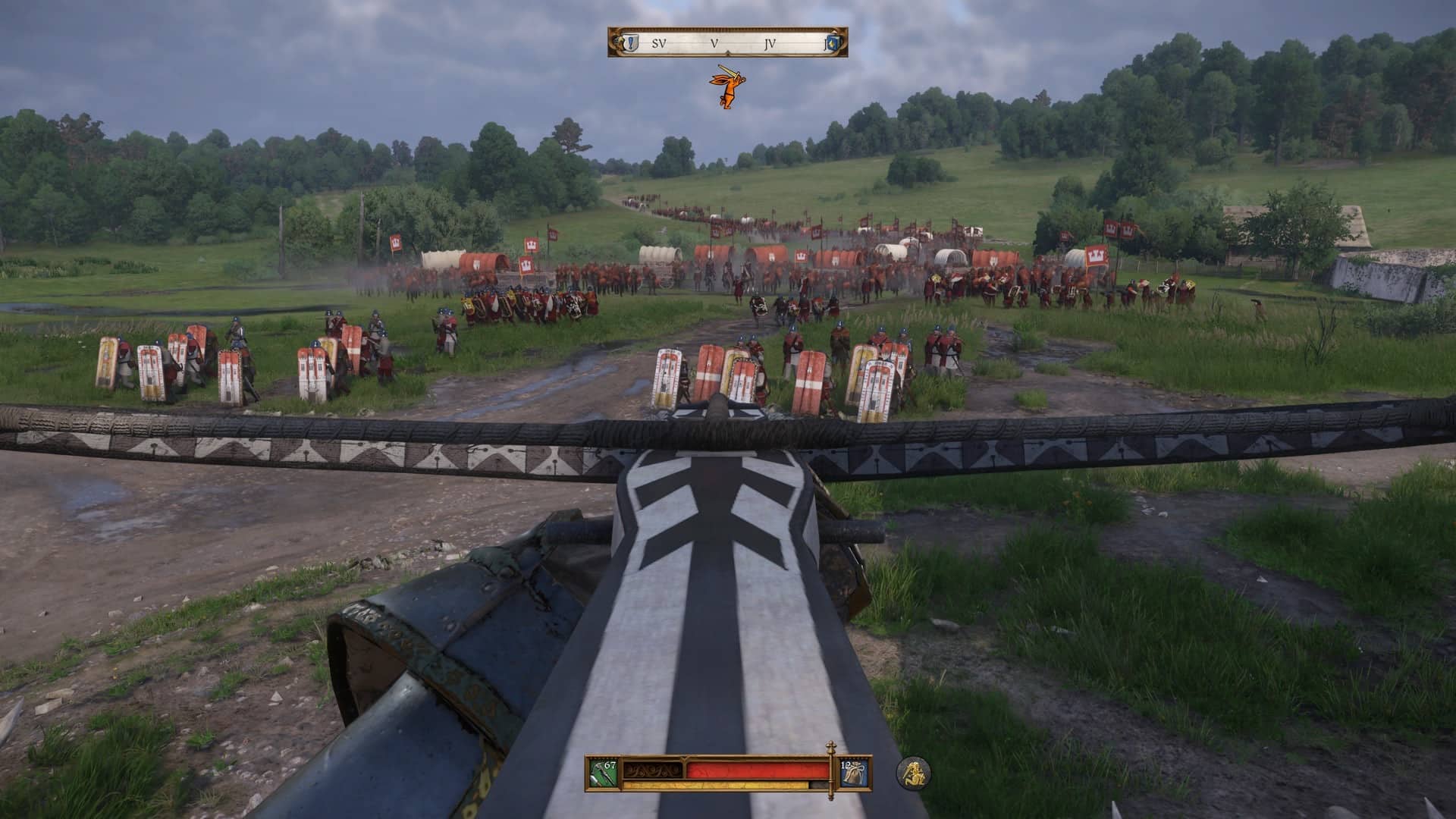Estimated reading time: 14 minutes
The Bigger, Prettier, Better Sequel
The sequel to Kingdom Come: Deliverance from 2018 is exactly what most fans wanted – bigger, prettier, and better written. Anyone who liked the first installment need not hesitate to buy it. However, a few annoying mechanics mean they’ll have to prepare for a few moments of frustration in addition to the sheer fun.
A Bold Bet on Realism
It’s hardly surprising that the big publishers were not keen on funding the first Kingdom Come at the time. Amongst all those enticing fantasy worlds full of bloodthirsty monsters, the countryside of the Bohemian Kingdom in the early 15th century looks all too ordinary. Especially when, most of the time, instead of heroic deeds, we’re just trying to survive until the next day and fighting ordinary bandits rather than dragons. But, as the old saying goes, less is sometimes more. The game ultimately proves that the target audience, which prefers realism to glitz and doesn’t want to be constantly led by the hand, is much larger than expected. With eight million copies sold, it was clear that the brand would not stop with one game.
Same Core, Bigger Scope
Ultimately, it took six long years for the sequel to be officially confirmed and an extra year before it came out. That’s a long time in which a lot has happened in the gaming industry, but Kingdom Come: Deliverance II ignores most of the innovations except perhaps technological advancements and was made with a clear goal in mind- to give players more of the same things they liked last time. In other games, we view such going around in circles negatively, but KCD is so unique in so many ways that it’s a definite positive.
There simply hasn’t been a similar play with such high production values on the Czech domestic scene since. As a result, this is a similar style of sequel to Fallout 3 and Fallout New Vegas in the past – we get the same game at first glance, but on a much larger scale, more polished and improved in every way.
Returning to Henry’s Story
I’ve styled the review assuming that you have at least a basic idea of how Kingdom Come actually plays. Despite the developers claiming that it is possible to jump straight into Henry’s story without any experience with the first game, it is highly recommended. Turning on the second game in the first few moments makes you feel like you’ve returned to a favorite pub after years to see long-unseen friends. All the while, it feels like the last meeting was yesterday, not nearly seven years ago. Yes, the graphics are much nicer, of course, but you’d swear the original game didn’t look much worse, and the plot directly follows the first game’s ending.
The protagonist Henry and his friend John Ptáček travel to Trosky Castle, accompanied by a handful of knights, to negotiate peace with the local lord, Ota of Bergova. But as it happens in games, something goes wrong on the way. After a while, you find yourself again without equipment, friends, and wounds in the enemy’s rear, and you have to work your way back to the top from the bottom.
A Familiar Yet Challenging Start
This somewhat classic insistence on a classic RPG story arc is a bit self-indulgent, but so be it, no one complained about it in The Witcher, for example. The problem is that, unlike most games, KCD is ironically at its most challenging in its opening, when you don’t even have enough money for a night in a pub, let alone the much-needed Savior Schnapps. The first sword you find is more dangerous to you than to your enemies, and traveling without a horse is extremely tiring. Of course, no one probably expected a classic fantasy from the slice-of-life where you slay your first dragon right at the start, and the protagonist is the ultimate thunderer outclassing his opponents. Yet, by this time, Henry should be a seasoned veteran of several stiff battles. Not every other peasant would have fallen for him even if he’s only wearing beggar’s clothes.
But a first glance at his personal stats makes it clear that everything necessary has yet to be learned. The RPG system here is quite complex, but it’s not complicated; it’s more about grinding numbers than behaving appropriately. You can see this well in diplomacy, for example – you can try threatening, bribing, or flattering. Of course, more important than the value of the attribute in question is an estimate of the nature of the other party. All attributes improve as you use them, and you buy perks with the points you accumulate as you level up.
Living with the Harsh Realities
So, the first few dozen hours will again be spent caring for Henry’s basic physical needs rather than going on adventures. In fact, the game stubbornly simulates many mechanics that aren’t very traditional or for the casual gamer and their weaker patience. Food in your inventory spoils, weapons dull and break, shields crack, clothes get dirty, wounds bleed… All this at a frightening rate, so after practically every other encounter where you take a hit, you’ll have to get your wounds treated. Which isn’t easy.
Weapons are repaired by a weaponsmith, clothes are worn by a tailor, dirt is only washed off properly in the baths, and wounds are only healed by rest or a more potent healing potion. None of this is free, so you’ll spend most of the money you earn just running the place. All this at a time when the plot hasn’t taken off enough to grab you.
In short, anyone who expected the developers to sharpen the edges too much under the supervision of an experienced publisher was waiting in vain. Despite the complications, the game is still just as raw and inaccessible as last time. I very much welcome that they haven’t compromised on their original core and brought in even more new mechanics to complicate things further. But more about those later, now it’s time to praise.
Exploring a Believable Bohemia
Once you get your bearings in the new environment and get at least the basics down, everything finally clicks, and you become a natural part of a virtual world that feels more believable than any other. Just walking through a landscape modeled on actual topographic data is an experience and must delight anyone who has enjoyed walking and wandering through nature. The gently undulating landscape of Bohemian Paradise may not be able to compete with the ice-covered rocky massifs of Skyrim at first glance.
Make no mistake, when Trosky Castle first appears on the horizon, you will gasp. Then, the second time, you realize you can go and take a screenshot at the same place where they now charge admission to see the remains of this majestic castle. It’s paradoxical, but while visiting the ruins back then, one imagined what it might have looked like six centuries ago, with the game, on the other hand, one can imagine where one took photos of the area on holiday.
And what about when you visit Kutná Hora. Most of the game is spent in the wild countryside and small villages, but after some fifty hours, you finally visit a real town. The first sight of the massive fortifications and the sprawling St. Barbara’s Cathedral is breathtaking. Still, the majesty is gone once you enter through the city gates. The authors have gone to great lengths to get as close to the period atmosphere as possible. They may have avoided the classic stereotype of the depressing Middle Ages.
Still, they are also far from the glitzy aesthetic of Czech fairy tales. The streets are full of horse dung smoke, and beggars are everywhere, and the wealthy nobility hides behind the walls of their luxurious mansions. By that time, however, you won’t be surprised; thanks to the interestingly developing storyline, you will have no illusions about the ruling class of the time.
The Crew of Questionable Knights
Henry surrounds himself with a company of peculiar mercenaries who, although their hearts are in the right place, do everything they can not to let it show. While this crew doesn’t have the chemistry some movies crave because just talking dirty and boozing isn’t enough on its own, you’ll still grow to like some of its members.
After all, they get plenty of room to do so, and as far as the main storyline goes, the game’s overall feel is almost cinematic. Plenty of non-interactive animations, dialogue, and scripts are backed up by great dubbing. Even the home fans will be in for a treat, with perhaps the best dubbing done in the Czech Republic since the first Mafia in 2002.
And what about the hunda. It reacts smoothly to the surrounding action, so in the vast battles, you can hear powerful chants, while on frequent visits to pubs, you can hear catchy chants. In terms of cinematic presentation, director Daniel Vávra’s handwriting is undeniable, giving a nod to his iconic Mafia, only with a far bigger budget to boot.
Combat: Refined Yet Demanding
The combat system has been dramatically simplified compared to the last game, but it still requires a lot of learning. It has an entirely different dynamic than you may know from other games – you need to learn the right timing, adapt tactics to various types of enemies, and learn how to move around the battlefield. Or you can skip that, and instead of direct confrontation, you can sneak around in the shadows and move outside the main action. Sometimes, this approach is more challenging, but other times, it’s easier.
However, you always have a choice. This also applies to most of the optional quests, which have also been given a lot of attention and often contain such good ideas that one is sorry that many players may miss them. This is likely because the game is genuinely enormous, and if you don’t want to run through it as quickly as possible, you’ll leave at least a hundred hours in it, as was the case with mine.
Forging, Surviving, and Everything Else
The authors still stand by the idea that the more activities they simulate realistically, the more fun it will be. This can be seen well in the new minigames, such as forging. You can craft your own equipment, from simple horseshoes to rare blades, but it’s not just that. As well as getting the necessary raw materials, you’ll need to forge each item yourself – melt the furnace, heat the goods to the ideal temperature, and rhythmically and evenly hammer them into shape on the anvil. You have to repeat the routine for several minutes at a time, and the result can be that you mess it up or make a first-class piece with a little effort and care.
But sometimes you will be worried whether you will mess it up, but that is part of it too, isn’t it? Fortunately, in the vast majority of cases, you can avoid these activities, but on the other hand, they are tightly intertwined with side tasks that you would otherwise miss out on. Typically – character A will task you with forging a few horseshoes for character B, who has yet to actually do the quest, so completely ignoring the forging brings all sorts of complications. One usually prefers to go and work virtually for a few minutes.
A Game Like No Other
This is a different form of grinding, familiar from classic RPGs, which the game otherwise tries to define itself against at all costs. Once you get to a certain level, it is no longer an actual survival game where you would be forced to fight for scarce resources, but taking care of Henry still plays a role until the end of the game. The authors have tried to make the game as realistic as possible, but the areas they didn’t want to simulate are all the more apparent.
Why do I have to deal with bloody clothes and not, for example, a burning torch? Why do I need to take care of my weapons but not my animals? Where does Henry go to the bathroom, where does he keep taking pebbles to distract his enemies, and how is it that after two days of drinking, he can make love for three hours straight?
I mean this with great exaggeration, of course, but cutting back on unstimulating and repetitive activity would only benefit the play in my eyes. It does offer a lot anyway. Kingdom Come Deliverance 2 is a phenomenon that ignores current events in the games industry and does things its own way. This is highly refreshing to both active gamers who are bored with the current mainstream production and complete newcomers.
Raw, Frustrating, and Rewarding
The game’s attempt to do everything differently at all costs is sometimes counterproductive, yet everything works precisely as it should. This is one of the most substantial experiences you can take away from a video game. Sooner or later, however, there comes a point where instead of fun, there is a small amount of frustration that you have to work around with your ingenuity and preparation for each situation, which is, of course, a refreshing approach on the one hand anyway, it just can sometimes seem too much for weaker natures. But that doesn’t change the fact that here we have one of the most distinctive interactive works of recent times, and we definitely recommend giving it a go. Medieval and Czech history has never been more entertaining.
About the Game
Title: Kingdom Come: Deliverance II
Type of Game: Action Role-Playing Game (RPG)
Developer: Warhorse Studios
Publisher: Deep Silver
Release Date: February 4, 2025
Platforms: PC, PlayStation 5, Xbox Series X/S
Platform Reviewed: PS 5 and PS5 Pro
Where to PurchasePC:
- Epic Games Store: Available for purchase at Kingdom Come: Deliverance II on Epic Games Store.
- Steam: Available at Kingdom Come: Deliverance II on Steam.
- PlayStation 5: Purchase through the PlayStation Store.
- Xbox Series X/S: Available on the Microsoft Store.
Note: The game is available in Standard and Gold Editions. The Gold Edition includes the base game, the Expansion Pass with three upcoming expansions, and the Gallant Huntsman’s Kit. Pre-ordering any edition grants access to “The Lion’s Crest” bonus quest.



